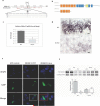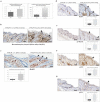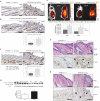Increased Susceptibility to Skin Carcinogenesis Associated with a Spontaneous Mouse Mutation in the Palmitoyl Transferase Zdhhc13 Gene
- PMID: 26288350
- PMCID: PMC4898190
- DOI: 10.1038/jid.2015.314
Increased Susceptibility to Skin Carcinogenesis Associated with a Spontaneous Mouse Mutation in the Palmitoyl Transferase Zdhhc13 Gene
Abstract
Here we describe a spontaneous mutation in the Zdhhc13 (zinc finger, DHHC domain containing 13) gene (also called Hip14l), one of 24 genes encoding palmitoyl acyltransferase (PAT) enzymes in the mouse. This mutation (Zdhhc13luc) was identified as a nonsense base substitution, which results in a premature stop codon that generates a truncated form of the ZDHHC13 protein, representing a potential loss-of-function allele. Homozygous Zdhhc13luc/Zdhhc13luc mice developed generalized hypotrichosis, associated with abnormal hair cycle, epidermal and sebaceous gland hyperplasia, hyperkeratosis, and increased epidermal thickness. Increased keratinocyte proliferation and accelerated transit from basal to more differentiated layers were observed in mutant compared with wild-type (WT) epidermis in untreated skin and after short-term 12-O-tetradecanoyl-phorbol-13-acetate treatment and acute UVB exposure. Interestingly, this epidermal phenotype was associated with constitutive activation of NF-κB (RelA) and increased neutrophil recruitment and elastase activity. Furthermore, tumor multiplicity and malignant progression of papillomas after chemical skin carcinogenesis were significantly higher in mutant mice than WT littermates. To our knowledge, this is the first report of a protective role for PAT in skin carcinogenesis.
Figures






References
-
- Benavides F, Stern MC, Glasscock E, et al. Microsatellite DNA variants between the inbred SENCAR mouse strains. Mol Carcinog. 2000;28:191–5. - PubMed
-
- Budunova IV, Perez P, Vaden VR, et al. Increased expression of p50-NF-kappaB and constitutive activation of NF-kappaB transcription factors during mouse skin carcinogenesis. Oncogene. 1999;18:7423–31. - PubMed
Publication types
MeSH terms
Substances
Grants and funding
LinkOut - more resources
Full Text Sources
Other Literature Sources
Medical
Molecular Biology Databases

